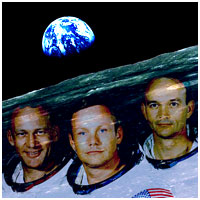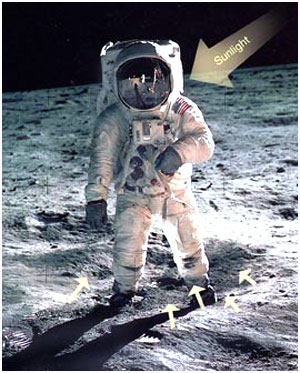One of the incentives for designing and building this site was the fact that my sister's 11-year old was informed by the head teacher at her school in Chichester... that man never went to the Moon, that it was all a hoax. In an age where conspiracy theories abound, I wonder why it is that adults are prepared to believe that the Apollo programme was fictitious and yet are equally prepared to believe that "Area 51" houses crashed flying saucers and dead aliens? It is a fact that our current level of technological advancement would be at least ten years behind if not for the manned space programme... you would probably not be sitting at your p.c. reading this right now! The building of the Saturn 5 launch vehicle alone was our equivalent of building the Great Pyramid. When Kennedy announced that we were going to the Moon... no body knew how to do that. Yet, it was done within the decade. In 1969 I witnessed mankind step off this world and set foot (in the name of all mankind), on a new one. For a short moment in time, the world was as one. We looked back at the Earth from the Moon. They weren't Americans on the Moon, they were our brothers, our fellow human beings, representatives of our humanity... a humanity that exists all alone, on a small blue planet in the emptiness of space. The generation that followed (my own), has not achieved anything by way of comparison. Forget the motives, the reasons for going... what we have, was built on the back of it. ...What we forgot, was all that we learned in that short moment in time. |
  |
|
NOW READ DAVID A. HARDY'S NEW ARTICLE? THE GREAT MOON-LANDING HOAX? As I write these words it is exactly 35 years since men first landed on the Moon. That was on 20th July 1969. It was an amazing achievement - but apparently up to twenty per cent of Americans (that's one in five) believe that it never happened but was nothing more than a hoax perpetrated by NASA, and many British people (especially those who are too young to have witnessed the adventure) seem uncertain too. This seems incredible to those of us with any knowledge of the subject, and most of us would prefer to ignore such patently stupid allegations, which come mainly from some people who have made money out of books and TV appearances in which they explain all the 'mistakes' made by NASA. Enormous publicity was given to it by a documentary transmitted twice in 2003 by Fox TV in the USA, and later by Channel Five in the UK. I decided to refute each claim only because it is useful to have ammunition and hard facts when confronted by someone who has believed them! (I might add that I witnessed the launch of Apollo 15 in 1971 - an experience I shall never forget.) The two main proponents of this theory are Bill Kaysing, former head of technical publications at Rocketdyne (which made some of the motors for Apollo, and who claims the CIA has made five attempts on his life in order to silence him), and Ralph Rene sometimes described as a 'scientist' and sometimes as a 'self-taught engineer', and author of NASA Mooned America. Both claim that NASA could not have got to the Moon in 1969, and would not have risked the lives of the astronauts, so either they went to the top of the launch gantry and were smuggled back down, or they went into Earth-orbit but no further. They say that the landings were actually filmed in Area 51, a top secret military base in the Nevada Desert, USA. (This is also where other conspiracy theorists say the US military are hiding captured UFOs, and even dead aliens. . .) Kaysing claims that the Russians never intended to go to the Moon. But they did; cosmonaut Alexei Leonov told me so himself! And had the Soviet government suspected that the USA was committing a fraud, they would have been the first to reveal the fact. I believe that such accusations are an insult to the brave astronauts who risked their lives, and to the millions of people who were involved in the planning and building of the spacecraft, launch facilities, communications, and so on. For the claims to be true, all of the 400,000 workers directly involved in the Apollo project were either duped too, or are very good at keeping a secret! We all know that this is impossible, but it does not silence the theorists. Furthermore, you need only to look properly at the thousands of wonderful photographs and movie footage to know that they are genuine; even today, our digital techniques could not match this. As photographer H.J.P. (Douglas) Arnold says: "They are literally out of this world, and to say they are a fraud demeans the achievement." Most scientists simply ignore this whole matter and quite reasonably refuse to dignify the accusations by treating them seriously. Sir Patrick Moore commented that "their ignorance of science is so complete that it is pointless to argue with them." However, since most people will not have the necessary knowledge to be sure whether there is any truth in what they say or not, and since some of the points do at least look superficially as if they could be genuine, let's examine the 'Top Ten' claims: |

Looking back at the Earth from the Moon: You can't see the stars for the same reason as you would not be able to see them if you were in a football stadium at night with the flood lights on! The Sun is extremely bright in space. 
Trick of the light: Buzz Aldrin on the lunar surface... David's arrows indicate how sunlight is reflected by the Lunar soil and the space suit... can't see the camera - crew reflected in his visor... can you? 
The "Eagle" returns: Armstrong and Aldrin pilot the Ascent Stage of the Lunar Module to rejoin Collins orbiting in the Command Module high above the Moon... That's us on the horizon. |
1. In 1968 Stanley Kubrick's film 2001: A Space Odyssey was released in cinemas, and showed moonscapes which looked remarkably realistic. The video pictures transmitted by Apollo and shown world-wide on TV were of much worse quality; was this done intentionally, by adding 'noise' and blurring, in order to hide any defects in the special effects? The shot of Armstrong descending the ladder on to the Moon is particularly bad - and anyway, who took that?
This is one of the more believable theories, and it has echoes in the 1978 film Capricorn One, in which a Mars landing is faked with a movie set. However, as in that film, the action would have to take place in a relatively small area, and whereas the crew of Apollo 11 moved only a few metres from their lander, later missions explored wider and wider areas. As for that first TV picture, there was a camera attached to the outside of the lander, which was deployed as Neil left the airlock.
It was of course very unfortunate that during Apollo 12, Alan Bean accidentally pointed the camera at the Sun and fried its optics, so there were no live TV transmissions! (This is of course seized upon as being deliberate on NASA's part, to save having to provide pictures.) However, they did land within 200 metres of the unmanned probe Surveyor 3, which had landed in 1967, and they brought back photos and film of this, as well as portions of the spacecraft. Apollo 15 carried the first Lunar Rover, and the dust thrown up by its wheels during its long drives clearly follows parabolic trajectories in the low gravity, quite unlike the behaviour of dust in our atmosphere. The weird, dreamlike motion of the astronauts is also only achievable in low gravity; it has been suggested that slow-motion can simulate this, but experiments to duplicate this have been only partially successful.
Remember that such a film set could hardly be outdoors; there had to be a black sky behind every scene - a very difficult feat to achieve, especially with a moving camera (we'll come to the stars later. . .), and any breeze would cause just the kind of problem which is in fact seized upon by the conspiracy theorists. Huge areas of land were therefore covered, and it would have been impossible in 1969-72 to simulate this. It may be noted that the quality of the pictures improved in later landings, with better equipment, and they also had larger TV antennae.
Continued on next page


